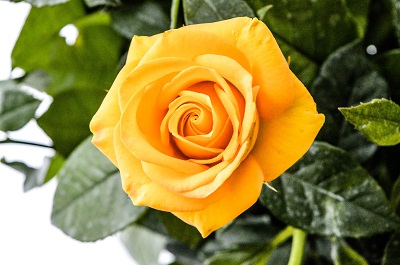‘Absolutely Fabulous’, ‘Beehive Gold’, ‘Diamonds Forever’, ‘Gisborne 2000’. What are they, and what do they all have in common? If you answered ‘roses’ to the first question and ‘the colour yellow’ to the second, you’re correct. Yellow roses are so appreciated that there are now dozens of varieties to choose from, with many of them also offering delicious perfume. We now take yellow roses so much for granted, that we forget the golden pigment wasn’t always represented in garden varieties.

As rare as gold
The 18th century was a hugely busy time for rose breeders. Prior to this period, there were only two dozen varieties of rose to choose from. By the end of the era, there were over 1,000! However, despite the prolific breeding programmes that were going on all over Europe, the many rose varieties available to gardeners were all in shades of pink and white. Then, although we can’t accurately pick the date, yellow was discovered in roses growing in the Middle East and Afghanistan. What’s more, they were blooming in several different shades from pale lemon to deep sulphur. They stunned European plant breeders who immediately set about developing hybrids.
The first yellows
The early yellow species of rose were Rosa Ecae, Rosa Foetida and Rosa Hemisphaerica.
Rosa Ecae was discovered growing wild in Afghanistan and Turkestan in 1880 by Dr Aitchison. He honoured his wife by using her initials to name it. Rosa Ecae is a tall bush growing to around 1.50 metres with very thorny brown stems and small serrated-edged leaves. Its bright yellow flowers are similar in shape and tone to those of Hypericum.
Rosa Foetida was found growing wild in the foothills of the Caucasus Mountains in what we now call Georgia. Some describe its scent as unpleasant while others don’t find it as objectionable. Foetida is spindly and grows up to 6 metres high. It is best known for its contribution to the development of ‘Soleil dÓr’.
Rosa Hemisphaerica is little more than a prickly shrub. It is spring blooming, only, and grows to about 1.5 metres. Its blooms have 5 single petals, and the bush takes its name from its hips which are half-rounded in shape. The species, commonly known as the ‘sulphur rose’ due to its unpleasant scent, was first discovered growing in western Asia.
Not without problems
While the results of hybridising were successful, yellow roses were found to be very weak at combating black spot. In other respects, they were also weak, and failed to thrive as their pinker cousins did. Just as frustrating, they lacked a pleasing perfume. Plant breeders, however, refused to give up, and although black spot today is often more of a problem in yellow roses, perfume, along with flower shape and size, are very pleasing to growers, and the range of yellow shades being developed continues to astound.
A rose with meaning
The colour yellow is imbued with connotations of well-being, good cheer and happiness. In the East, it is also associated with wisdom and power. This is why yellow roses today are so often chosen to carry a message of congratulations.









Join the Discussion
Type out your comment here:
You must be logged in to post a comment.